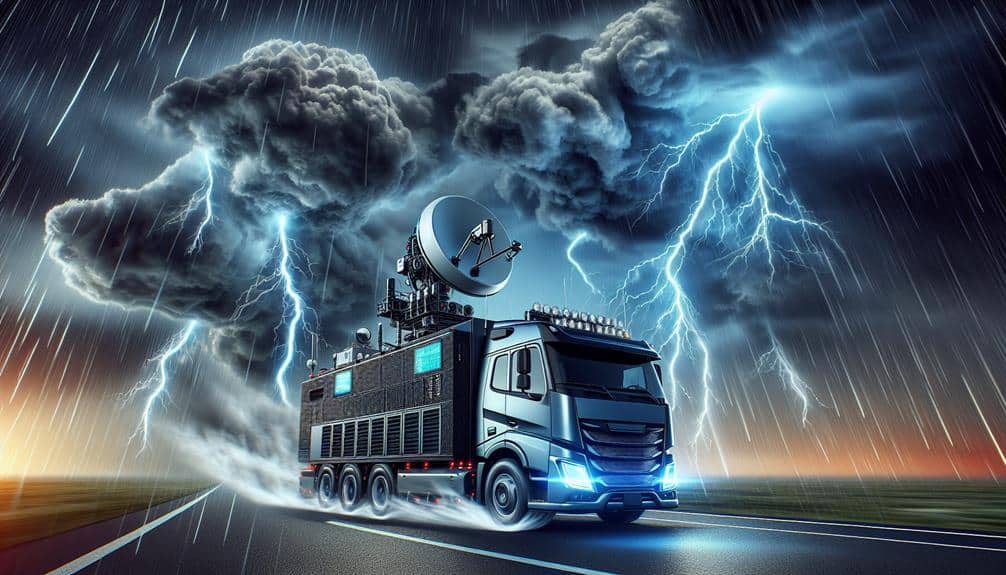We've identified the top 10 affordable tornado intercept vehicle options for those on a budget. Modified pickup trucks and reinforced SUVs excel due to their durability and DIY upgrade potential. Budget sedans and compact crossovers offer cost-effective safety features with good maneuverability. Used military vehicles like Humvees provide exceptional ruggedness, while ATVs cover difficult terrains. Affordable RV conversions, economical trailers, and secondhand storm chasers offer versatile and thrifty alternatives. Each option blends affordability with essential storm-chasing capabilities, ensuring safety and reliability in extreme conditions. To see our detailed analysis, explore the specifics of each choice.
Key Points
- Modified Pickup Trucks: Robust, versatile, and cost-effective with DIY modifications like reinforced glass and heavy-duty bumpers.
- Reinforced SUVs: Enhanced structural integrity with roll cages, skid plates, and heavy-duty suspensions for off-road capability.
- Budget Sedans: Affordable safety features like electronic stability control and anti-lock braking systems with lightweight materials for durability.
- Used Military Vehicles: Rugged and budget-friendly options like Humvees from military surplus with high ground clearance.
Modified Pickup Trucks
When considering affordable tornado intercept vehicles, modified pickup trucks stand out due to their robust construction, versatility, and cost-effectiveness. For those of us who thrive on freedom and adventure, these trucks offer a platform ripe for DIY modifications and budget-friendly upgrades. Pickup trucks, especially models like the Ford F-150 and Chevrolet Silverado, have durable frames that can withstand the extreme conditions often encountered during tornado intercepts.
We can enhance their performance and safety through practical modifications. Reinforcing the vehicle's undercarriage and adding roll cages are essential for withstanding debris impacts. Additionally, installing reinforced glass and heavy-duty bumpers further increases durability. These upgrades are budget-friendly compared to commercial intercept vehicles, costing typically between $1,500 to $5,000.
Moreover, custom paint jobs and personalized interiors aren't just for aesthetics; they serve practical purposes. Bright colors improve visibility in stormy conditions, while a personalized interior can optimize space for essential equipment like radar, communication devices, and emergency supplies.
Reinforced SUVs
Let's examine the benefits of reinforced SUVs, focusing on their enhanced structural integrity and off-road capability boost.
Enhanced Structural Integrity
Reinforced SUVs, designed with enhanced structural integrity, are important for providing both safety and durability during extreme tornado interception missions. When we evaluate structural reinforcement, cost analysis becomes necessary to guarantee that these vehicles remain within an affordable range without compromising on safety. Key structural enhancements typically include reinforced chassis, advanced roll cages, and impact-resistant materials.
For those of us who prefer a hands-on approach, DIY stormproofing offers a practical solution. Affordable upgrades can greatly enhance a vehicle's durability. Key modifications may include:
- Strengthened Windows and Panels: Using polycarbonate windows and reinforced steel panels to withstand high-velocity debris.
- Roll Cages: Installing a well-engineered roll cage to maintain cabin integrity during a rollover.
- Skid Plates and Underbody Protection: Adding skid plates to protect essential components from ground impact.
In our cost analysis, these DIY upgrades generally fall within a budget-friendly range, making them accessible for most storm chasers.
Off-road Capability Boost
Enhancing off-road capability in strengthened SUVs is necessary for traversing the rugged terrains frequently encountered during tornado interception missions. We need to guarantee our vehicles can handle everything from muddy fields to rocky trails. Off-road modifications and performance upgrades are pivotal to achieving this.
Firstly, let's talk about suspension systems. Upgrading to heavy-duty, adjustable suspensions provides the necessary ground clearance and improved handling on uneven surfaces. Additionally, reinforced shock absorbers can absorb the high-impact forces encountered in off-road conditions, ensuring a smoother ride and better vehicle control.
Next, tire selection is crucial. All-terrain tires offer a balanced performance across various types of off-road environments. They provide superior traction in mud, sand, and gravel, while also being durable enough to withstand sharp debris that might puncture standard tires.
Performance upgrades like enhanced powertrains are another key component. High-torque engines paired with robust transmission systems ensure that our SUVs can power through difficult terrains without compromising speed or reliability.
Budget Sedans
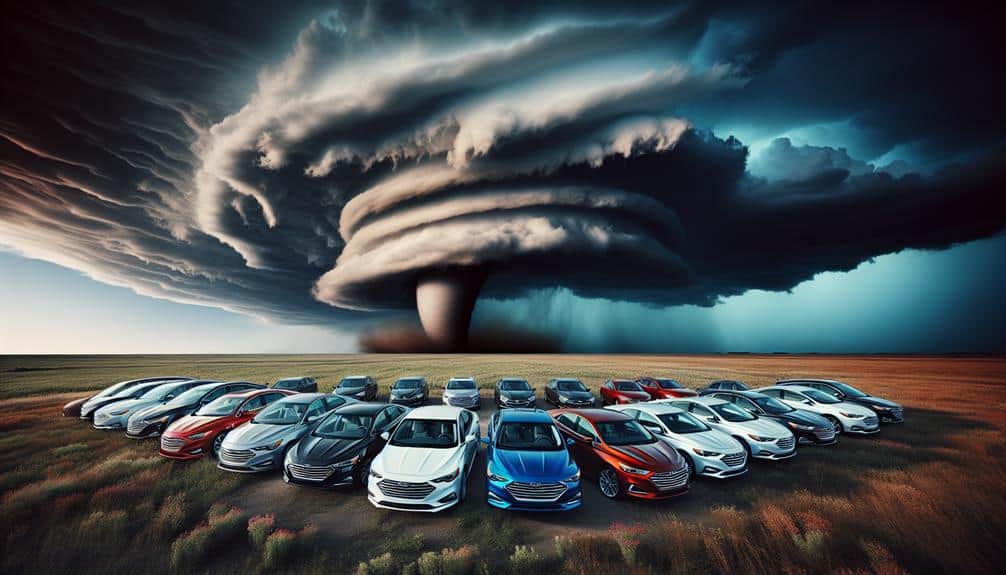
Let's talk about budget sedans, which offer cost-effective safety features and robust build quality essential for tornado interception.
We can analyze models like the Toyota Corolla and Honda Civic, both known for their affordability and reliability.
Detailed crash test data and consumer reports show these sedans perform well under stress, making them viable options for our needs.
Cost-Effective Safety Features
Many budget sedans integrate cost-efficient safety features like advanced airbag systems, electronic stability control, and anti-lock braking systems to enhance occupant protection without greatly increasing the vehicle's price. These budget-friendly adjustments and safety upgrades are designed to provide maximum value without breaking the bank.
It's clear that freedom-loving adventurers need reliable, value-driven vehicle options with cost-efficient upgrades that guarantee safety during unpredictable weather conditions.
Let's explore three essential safety features commonly found in budget sedans:
1. Advanced Airbag Systems:
Modern sedans often come with multiple airbags, including front, side, and curtain airbags. These systems deploy strategically to protect occupants from different angles during a collision.
2. Electronic Stability Control (ESC):
ESC helps maintain vehicle control during extreme steering maneuvers by automatically applying brakes to individual wheels. This feature significantly decreases the risk of skidding or rollover.
3. Anti-lock Braking Systems (ABS):
ABS prevents the wheels from locking up during sudden braking, allowing drivers to maintain steering control. This is vital for avoiding obstacles and maintaining stability on slick roads.
Durable Build Quality
While cost-effective safety features are essential, the durability of budget sedans' build quality guarantees they can withstand harsh weather conditions and impacts, providing a sturdy shield for occupants.
When selecting a tornado intercept vehicle, we need to focus on lightweight materials that enhance off-road performance while maintaining structural integrity. High-strength steel and advanced composites strike a balance between weight and durability, ensuring the vehicle remains agile and robust under severe weather conditions.
Aerodynamic design plays a significant role in impact resistance. A streamlined body reduces wind resistance, allowing the sedan to maintain stability and control during high-speed chases through turbulent conditions. This aerodynamic efficiency also aids in fuel economy, essential for long-distance storm tracking.
Data indicates that budget sedans incorporating reinforced chassis and crumple zones effectively absorb and dissipate collision forces, enhancing occupant safety. Additionally, weather-resistant coatings and corrosion-resistant materials extend the vehicle's lifespan and reliability.
Compact Crossovers
Compact crossovers offer a balanced blend of maneuverability, safety features, and storage capacity, making them viable options for tornado intercept missions. These vehicles provide a unique combination of fuel efficiency and cargo space, essential for lengthy chases and carrying necessary equipment. Their compact size allows for quick navigation through unpredictable weather conditions, while still providing enough room for radar systems and emergency supplies.
Let's break down why compact crossovers are a smart choice:
- Fuel Efficiency and Cargo Space: With their efficient engines, compact crossovers can cover more ground without frequent refueling stops. Additionally, their ample cargo space allows us to store required equipment like weather instruments and first aid kits.
- Technology Upgrades and Comfort Features: Modern compact crossovers come equipped with advanced technology such as real-time GPS, automated braking, and adaptive cruise control. These features not only enhance safety but also increase driver and passenger comfort during prolonged missions.
- Cost-Effectiveness: Compared to larger SUVs or specialized vehicles, compact crossovers are generally more affordable, both in terms of initial purchase price and ongoing maintenance costs. This makes them an economical choice for storm chasers on a budget.
Used Military Vehicles
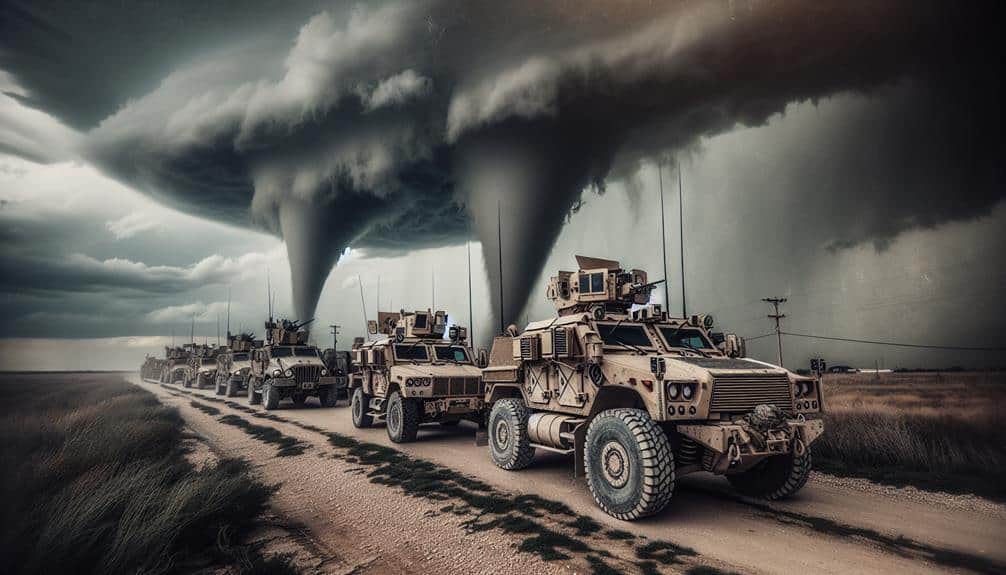
Used military vehicles offer unparalleled ruggedness and durability, making them an attractive option for tornado intercept missions requiring robust performance in extreme conditions. These vehicles, often sourced from military surplus, are built to withstand the harshest environments, which is precisely what we need when chasing tornadoes.
For affordable tornado hunters, used vehicles like the Humvee or decommissioned MRAPs (Mine-Resistant Ambush Protected vehicles) present budget-friendly options that don't compromise on safety or capability. The Humvee, for instance, features high ground clearance and a robust drivetrain, enabling it to navigate debris-strewn roads and off-road terrain effortlessly. Additionally, these vehicles come with reinforced structures that can endure the high winds and flying debris common in tornadic environments.
Data shows that military surplus vehicles can be acquired at a fraction of the cost of new, specialized storm chasing equipment. A used Humvee can be found for as low as $15,000, while an MRAP might be available in the $20,000-$30,000 range. This makes them not only a durable choice but also a cost-effective one, allowing us to allocate more resources to essential storm tracking technology and safety gear.
Custom Vans
Now, let's explore custom vans, starting with a detailed conversion cost breakdown that includes materials and labor.
We'll also analyze essential safety features like roll cages and reinforced exteriors to guarantee maximum protection.
Conversion Cost Breakdown
When calculating the conversion cost of custom vans for tornado intercept purposes, we need to take into account key components such as strengthened exteriors, advanced meteorological instrumentation, and upgraded suspension systems. By focusing on budget-friendly upgrades and a conversion cost comparison, we can identify cost-efficient ways to make our vehicles storm-ready.
Let's break down the major cost components:
- Strengthened Exteriors: Adding metal plating and impact-resistant materials can range from $1,500 to $3,000. These enhancements guarantee the van can withstand debris and strong winds.
- Advanced Meteorological Instrumentation: Installing tools like anemometers, barometers, and radar systems can cost between $2,000 and $5,000. These instruments are essential for real-time data collection and analysis.
- Upgraded Suspension Systems: High-quality suspension upgrades are necessary for handling rough terrains and can cost around $1,000 to $2,500.
For those looking to save, DIY modifications offer a cost-efficient alternative. Simple enhancements like reinforcing windows with polycarbonate sheets and adding basic weather sensors can be done for a fraction of the price.
Essential Safety Features
Securing our custom vans with essential safety features is crucial for protecting both the equipment and occupants during tornado intercept missions.
First and foremost, thorough emergency supplies are non-negotiable. This includes first aid kits, fire extinguishers, and high-visibility vests.
Each van must also be equipped with a robust communication system, integrating both satellite phones and two-way radios to maintain constant contact, even when cellular networks fail.
Proper vehicle maintenance is another key factor. Regularly scheduled inspections and servicing guarantee that our vans remain in peak operational condition, reducing the risk of mechanical failures during high-stress situations.
Detailed records of these maintenance activities should be kept, enabling us to anticipate and address potential issues before they become problems.
Furthermore, extensive training for all team members is essential. This training encompasses not only the operation of emergency equipment and communication tools but also the execution of safety protocols under duress.
Simulated tornado intercept scenarios can be invaluable in preparing our team to act swiftly and effectively when real-life conditions become hazardous.
Weatherproof Modifications
Weatherproof adjustments for our custom vans are essential to guarantee they withstand the harsh conditions encountered during tornado intercept missions. Let's delve into the necessary custom modifications and budget friendly upgrades that provide best vehicle protection enhancements.
First, we need to focus on strengthened exteriors. Using weather resistant materials like high-quality steel and composite panels ensures that our vans can endure debris impact and high winds. A sturdy exterior is our first line of defense.
Second, sealing and insulation are crucial. Properly sealed windows and doors prevent water ingress, while high-grade insulation materials keep internal temperatures stable, protecting both equipment and personnel. These enhancements are cost-effective and greatly improve vehicle durability.
Third, improved undercarriage protection is vital. Installing reinforced skid plates and splash guards shields critical components like the engine and fuel tank from mud, water, and debris. These modifications are budget friendly yet highly effective for long-term vehicle health.
We can't overlook the significance of these weatherproof adjustments. They not only extend the lifespan of our intercept vehicles but also ensure we maintain peak operational efficiency. By investing in these strategic upgrades, we achieve a balance of affordability and resilience, empowering us to navigate the storm with confidence.
All-Terrain ATVs
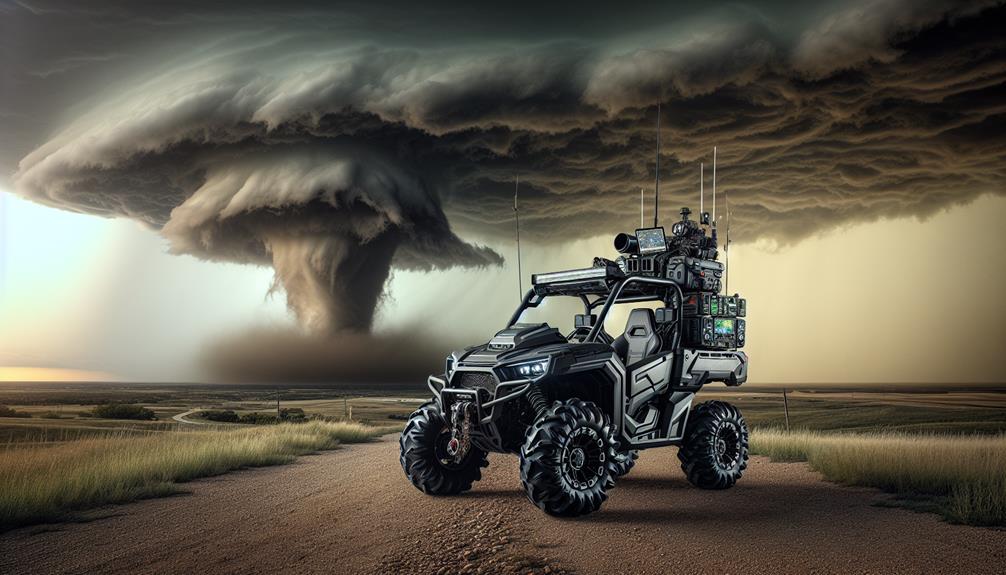
All-terrain ATVs provide the maneuverability and rugged durability essential for crossing the challenging environments typically encountered during tornado interception. Their compact size, robust suspension systems, and high ground clearance make them ideal for navigating debris-strewn landscapes or muddy fields.
To optimize our ATVs for tornado chasing, we can incorporate specialized ATV accessories and tornado chasing modifications. Essential accessories include reinforced roll cages, GPS guidance systems, and weather-resistant storage compartments for safety gear.
When it comes to DIY vehicle upgrades, we can focus on extreme weather preparation. Installing heavy-duty tires with deep treads ensures better traction on wet or uneven terrain. Adding protective skid plates shields the ATV's undercarriage from damage caused by flying debris. Additionally, outfitting our ATVs with auxiliary lights enhances visibility in low-light conditions, important during storm pursuits.
Data reveals that ATVs with a minimum engine capacity of 500cc offer the best performance for tornado chasing, balancing power and fuel efficiency. Investing in a winch system can also be invaluable, providing a means to extricate the vehicle from mud or other obstacles.
Affordable RV Conversions
Moving from the maneuverability of all-terrain ATVs, we now explore how converting RVs into tornado intercept vehicles offers a balance of mobility and on-site operational capabilities. Converting an RV provides ample space for equipment and amenities, making it a practical storm chasing solution without compromising the budget.
For those of us looking for cost-effective customization, DIY conversions are a viable option. We can source a used RV and equip it with necessary reinforcements and storm tracking technology.
Here's a breakdown of key considerations:
- Vehicle Selection: Opt for a sturdy, high-mileage RV with a reliable engine and chassis. Diesel engines are often more durable and efficient for long hauls.
- Structural Modifications: Strengthen the exterior with metal plating and secure all windows and openings. Add storm-resistant ventilation systems and guarantee the vehicle's weight distribution is balanced.
- Interior Customization: Outfit the RV with weather monitoring instruments, secure storage for sensitive gear, and sleeping quarters for extended missions.
This approach allows us to merge affordability with functionality, ensuring our vehicle is both resilient and equipped for practical storm chasing. By focusing on key elements, we can maximize our effectiveness while maintaining freedom of movement.
Economical Trailers
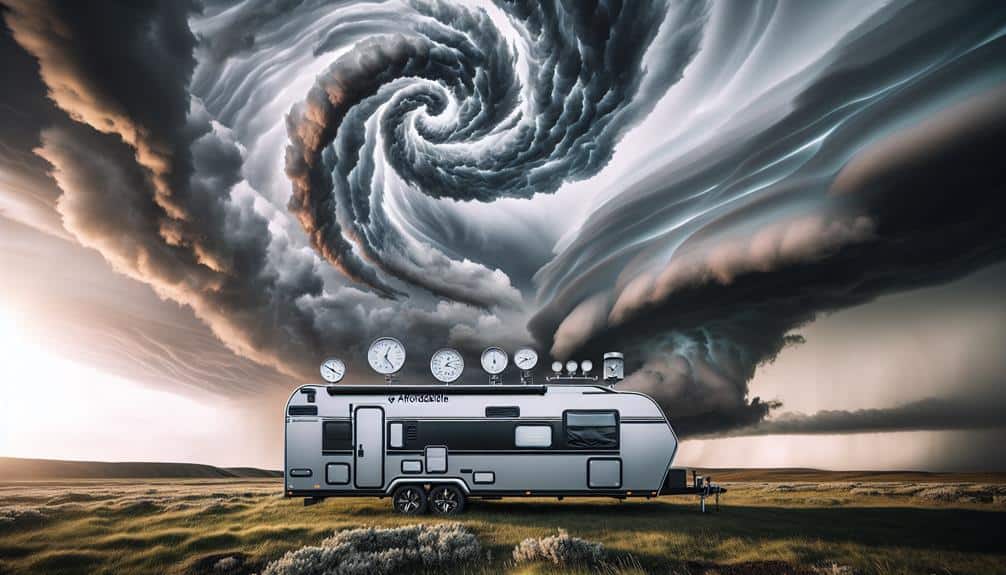
When considering affordable tornado intercept options, budget-friendly trailers offer a versatile and cost-effective alternative to traditional RVs. Lightweight design is a key feature of these trailers, reducing the towing capacity required and enhancing fuel efficiency. Most cost-effective trailers come with innovative storage solutions that maximize interior space, allowing us to pack all necessary storm-chasing equipment without compromising on comfort.
Aerodynamic features are another significant advantage. These trailers are designed to minimize air resistance, which not only improves fuel efficiency but also provides better stability in high winds—an essential factor when intercepting tornadoes. The streamlined shape ensures that the vehicle remains steady, even when traveling at higher speeds to track a storm.
In terms of towing capacity, most cost-effective trailers can be hauled by mid-sized SUVs or even some larger sedans, offering us greater flexibility and freedom in vehicle choices. This makes them accessible to a broader range of storm chasers, from seasoned professionals to enthusiastic amateurs.
With a focus on technical accuracy and detailed analysis, it's evident that cost-effective trailers present a practical and economical approach to tornado interception, balancing performance and affordability seamlessly.
Secondhand Storm Chasers
In addition to budget-friendly trailers, pre-owned storm chasers provide a cost-effective solution for those looking to intercept tornadoes without breaking the bank. When we opt for used vehicles, we can leverage economical modifications and DIY solutions to turn these thrift store finds into robust storm-chasing machines. Here's how we can maximize our investment:
1. Economical Modifications:
We can equip pre-owned vehicles with essential storm-chasing gear like reinforced windows, skid plates, and radar equipment. These cost-effective upgrades are crucial for ensuring our safety and obtaining accurate data during intercepts.
2. DIY Solutions:
By taking a hands-on approach, we can save significantly on labor costs. Installing custom shelving for instruments, adding storage compartments, and integrating GPS systems are all modifications we can handle ourselves. This DIY approach gives us the freedom to tailor the vehicle to our specific needs.
3. Bargain Hunting:
Scouring thrift stores, auctions, and online marketplaces for deals on pre-owned vehicles allows us to find high-quality options at a fraction of the cost. Vehicles such as older SUVs or pickup trucks can be found in good condition and provide a solid foundation for our storm-chasing endeavors.
Frequently Asked Questions
How Much Does Tornado Intercept Vehicle Insurance Typically Cost?
When considering insurance costs, we find that tornado intercept vehicle insurance typically ranges from $1,500 to $3,000 annually. Coverage options vary, often including detailed, collision, and liability to provide maximum protection during storm chases.
What Safety Training Is Required for Operating a Tornado Intercept Vehicle?
We need comprehensive safety regulations training, including vehicle maintenance protocols. Operators must complete courses on emergency response, meteorology, and defensive driving. Ensuring our equipment's reliability and understanding storm patterns are essential for safe operations.
Are There Any Financing Options Available for Purchasing Tornado Intercept Vehicles?
Yes, there are financing options available for purchasing tornado intercept vehicles. These include flexible payment plans and potential savings on interest rates. The benefits of financing allow us to manage costs while ensuring we have the necessary equipment.
What Is the Average Fuel Efficiency for Tornado Intercept Vehicles?
Did you know most tornado intercept vehicles average only 10-12 mpg? This low fuel efficiency can impact cost savings notably. To maximize our missions and conserve resources, we must consider both performance and fuel economy.
Can Tornado Intercept Vehicles Be Rented for Short-Term Use?
Yes, we can rent tornado intercept vehicles for short-term use, often through storm chasing tours or emergency response services. Rental availability and terms vary, so thorough research and planning are essential for best outcomes and safety.
